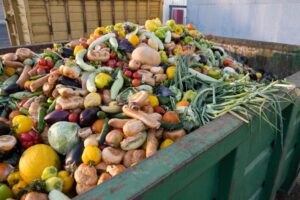Farmigo is an online farm-to-consumer service based in Brooklyn, New York that started life as a community supported agriculture software company. It differs from many in the food e-commerce segment in that it does not deliver food to customers’ doors, but drops them off at local pickup sites.
Last year, it raised $16 million in Series B funding from investors including San Francisco VC Formation 8 Partners, Benchmark Capital and Sherbrooke Capital.
Ahead of a speaking slot at the Future Food-Tech Summit in New York this week, AgFunderNews caught up with Benzi Ronen, CEO of Farmigo, to find out a bit more about the company’s journey so far.
What have been the biggest challenges for Farmigo?
We have a unique delivery model. We foster relationships with community organizers who run and host our pickup sites out of their homes, businesses, or even at their children’s school, where 10% of the community’s order revenue goes back to support fundraising initiatives. By tapping into the economies of communities, we remove the need for costly and inefficient door-to-door delivery, enabling us to spread easily into suburban, as well as urban, areas. We’re also helping foster connections between people who care about and love great food. There’s a human element that’s missing from other food delivery companies, and we’re proud to put people at the front and center of our operations.
This is core to who we are as a company, but it’s also been one of our greatest challenges: empowering our organizers to be the last mile to the customer while still creating some consistency in the consumer experience. So much is out of our hands, and likewise, from the organizer’s perspective, they’re representing a company they don’t technically work for and operations they don’t have much control over. It’s a tricky line to balance, and we’re always thinking of ways to do it more effectively.
How would you compare Farmigo to others in the farm-to-consumer and food e-commerce space?
We’ve curated amazing fresh and freshly-made foods from our region, cut out the middlemen that plague traditional grocery store food systems, and helped foster local food communities run by passionate volunteers who host our pickup sites. There are no subscription fees or minimum order requirements, so people are free to choose the assortment and quantity of foods they want week-to-week.
In addition to our delivery model, we are unique for a few reasons. One is our relationship with producers–we work directly with our farmers and food makers. Because we’ve cut out the middlemen and made what was a convoluted and wasteful distribution system — where every step along the way shaved a few cents off the farmer’s paycheck — clear cut and transparent, we’re able to give our partners about 2-3x the price producers receive through traditional grocery systems.
We also follow a “just in time” sourcing model for fresh local goods whereby, once we receive all our member’s grocery orders for the week, we send those quantities to our farmers and producers. This means only the amount that we need is harvested or made. Because we don’t hold much fresh inventory, we’re able to dramatically reduce the amount of food waste and spoilage that occurs with most grocery options. We also guarantee an unparalleled freshness.
What is the experience of your farmers?
By accessing a greater population of interested consumers, many of our farmers and food makers have been able to grow and scale their operations. We support them with marketing and logistics and help guarantee a year-round revenue stream. There’s also very little risk for the farms and small businesses we work with because they get paid for every single thing they pick or produce.
Here one quote of many we gathered from our partners for a year-in-review video we did in early January:
Patrick Rider from Greenane Farms in New York State
“Part of our Mission at Greenane Farms is to share great tasting, healthy, nutritious, and sustainable food with as many people as possible. In 2015 Farmigo has helped us do that in a very big way by getting Greenane Farms Pastured Meats from our farm in the pristine Catskill Mountains all the way to great folks in NYC; something that we as a small family farm are unable to do on our own. As a result of this support by Farmigo, our farm has further increased the size of our pastured chicken flock, our herd of Heritage breed pastured pigs, and our covey of Catskill Quail. This support has also provided us the opportunity embark on a new project in 2016, to build a larger on-farm meat processing and packing facility, provide employment to some upstate folks that really need it, and to help support our growing family of four children and another on the way in February!”
There have been some claims that a lot of startups in your segment are not really technology companies. How are you using technology at Farmigo?
Farmigo’s first product was software for farms to manage their CSA programs. It’s still a part of our business, and we’re the largest maker of CSA software in the country, with 300+ farms on the platform. It was this platform that served as the backbone of our first consumer product.
Beyond the fact that our shopping experience is entirely online — via web and mobile marketplaces– we use technology to optimize the logistical component of our operations. For example, our warehouses run on custom software: each packing station is outfitted with a tablet that not only tells the team what to do but also updates our delivery team’s dashboards in real time, which is one component of critical information they need to ensure as many on-time deliveries as possible.
Our backend powers our farmers much like Etsy powers its sellers. We have built a supply chain management system that tracks farmer and food maker inventory, and processing the packing and delivery operations.
On the consumer end, like AirBnB, we use technology to enable our organizers to manage their respective community sites. They can see who’s ordered and who has not — so they can send friendly reminders– how much much their site has raised, and easily answer questions and send communications to their members.
What are the biggest barriers to entry for new food e-commerce companies?
Given the current fundraising environment, I think the biggest barrier to entry for emerging companies will be raising ample capital to scale their businesses.
We recorded over $1.5bn of venture investment in food e-commerce last year, and that doesn’t include restaurant delivery services which raised even more. Is this sustainable?
No, this level of investment is definitely not sustainable, and we’re already seeing the purse strings tightening. Investors are starting to appreciate that food and tech businesses take longer to materialize big returns, and they’re choosing their investments very carefully.
Who are your investors and what value have they added thus far?
Benchmark, Sherbrooke Capital, Formation 8. Our investors/board members have added tremendous value to Farmigo. They’ve encouraged us to be patient, provided invaluable connections and introductions, and helped us evolve the business with strategic thinking and insight.
Are you going to raise more money soon?
Yes, we will seek additional capital in 2016 to fund our expansion.
Have news or tips? Email [email protected]















Sponsored
International Fresh Produce Association launches year 3 of its produce accelerator